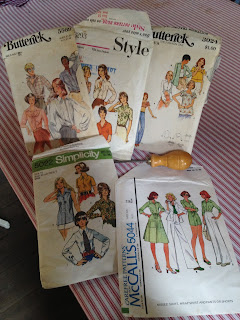The wet is a great excuse to stay in the sewing workshop, trace patterns and pursue the challenge of "the perfect House Dress". have had one success and one mediocre outcome. The success was unexpected, trialling an unusual Vogue pattern 1410.
The pattern has only two beautifully drafted pieces, so is quick and quirky. Buttons sewn onto the seams allow the bottom of the garment with buttonholes in seam, to be simply turned in to make the flattering billowing skirt. I made a few changes and fabric from a roll for old school uniforms...polycotton with a lot of body. As usual the trial fabric came up transformed and has already had an outing. We plan to see how a winter weight cord or drill would work with a white shirt or fine knit skivvy.

This dress is comfortable, quirky, quick to make and has several looks inbuilt from maxi to a top. I prefer the dress length pictured. Again, a great contender for 'the best house dress'.
Not so this one...
This was disappointing as the pattern was far too generous and the cut does not flatter. Darts, easing, structure and piecing can give a simple garment great shape and movement....this one had none of these. By trialling it in a heavy uncut cord fabric, I did the pattern no favours. That said it really needs a fabric with structure if not weight. On the positive side, it would be great for someone who is a plus size as the smallest size would equate to a 14-16. It is one of the few designs that incorporate a button front, collar, sleeveless and side pockets, and is comfortable if not flattering.
I changed the front to get rid of the bulk and hence the bigger overlap...not one of my best adaptations. I was really hoping for a 60's 'mod, skivvy, under a shift look...not really achieved.
Not giving up the challenge though to find the perfect house dress.
Finally, a word of advice to new sewers. If you see a pattern you like, buy it. The patterns become discontinued so quickly and are often quite expensive to purchase. Also, with students using different sizes we have become excellent at using the tracing wheel to copy patterns of specific sizes. A good serrated one is best, possibly Clover as although a little more expensive, the quality is there.






































